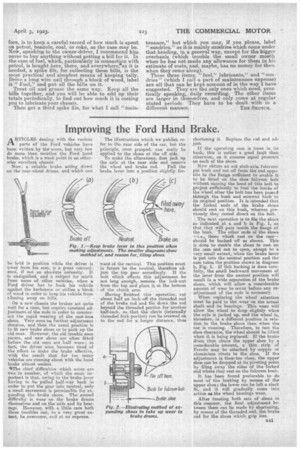Improving the Ford Hand Brake.
Page 25

If you've noticed an error in this article please click here to report it so we can fix it.
ETICLES dealing with the various parts of the Ford vehicles have been written by the score, but very few Ito more than mention the Ford hand brake, which is a weak point in an otherwise excellent chassis.
Now, a reliable brake acting direct on the rear-wheel drums, and which can
be held in position while the driver is away from his seat, is a great convenience, if not an absolute neZessity. It is undignified, and a subject for mirth from users of other vehicles, when a Ford driver has to back his vehicle against the kerbstone or utilise a 'block ot wood in order to keep his vehicle from running away on hills.
On a new chassis the brakes act quite well for a time, but require constant adjustment of the rods in order to counteract the rapid wearing of the cast-iron nhoes. Very soon no further adjustment tlemains, and then the usual practice is to fit new brake shoes or to pack up the old. ones. However, the old trouble soon recurs, and new shoes are often fitted before the old ones are half worn
fact, the driver soon becomes tired of the effort to make the brake effective, with the result that far too many vehicles are running about with the hand brake almost useless.
The chief difficulties which occur are two in number, of which the more imPortant is that, owing to the brake lever having to be pulled half-way back in order to put the gear into neutral, only a small movement is permissilile for ex• panding the brake shoes. The second difficulty is wear on the brake drums themselves and on the axle and its bearings. However, with a little care both these troubles can, to a very great ex. tent, be overcome, and at no expense. The illustrations which we publish refer to the near side of the car, but the principle, once grasped, can easily be applied to the shoes at the off side.
To make the alterations, first jack up the axle at the near side and remove
the wheel and brake rod. Pull the brake lever into a position slightly for ward of the vertical. This position must in future be the neutral, therefore adjust the top gear accordingly. If the bolt which effects this adjustment be not long enough, remove the lock-nut from the top and place it at the .bottom of the clutch arm. .
Having finished this operation, cut about half an inch off the threaded end of the brake rod and file down the rod beyond the threaded portion for another half-ineh, so that the clevis (internally threaded fork portion) can be screwed on to the rod for a longer distance, thus shortening it. Replace the rod and adinst.
If the operating cam is loose in itsbush, this is rather a good fault than otherwise, as it ensures equal pressure on each of the shoes.
Now obtain an old stub-axle fulcrumpin bush. and cut off from the end opposite to the flange sufficient to enable it to be fitted on the shoe fulcrum bolt without causing the head of this bolt to project ,sufficiently to foul the inside of the wheel after the bolt has been passed through the bush and screwed back to its original position. It is intended that the forked ends of the brake shoes should rest on this bush, whereas previously they rested direct on the bolt.
The next operation is to file the shoes as indicated at a. and b in Fig. 1, so that they will pass inside the flange of the bush. The other ends of the shoes —i.e., those which rest on the cam-should be backed off as shown. This is done to enable the shoes to rest on the cam and not to open, except to a rery email extent, when the brake lever is put into the neutral position and the . cam takes the position shown in diagram b, Fig. I. If this backing is done carefully, the small backward movement of the lever from the neutral position will result in a wide separation of the brake shoes, which will allow a considerable amount of wear to occur before any readjustment of the rods is necessary.
When replacing the wheel attention must be paid to the wear on the actual shaft and its bearings. This wear will allow the wheel. to drop slightly when the axle is jacked up, and the wheel is, therefore, in a different position in relation to the brake shoes than when the car is running. Therefore, to test the shoe clearance, the wheel should be lifted when it is being replaced. If the brake drum then clears the upper shoe by a considerable amount, a thin strip of Ferodo may be attached by copper or aluminium rivets to the shoe. If the adjustment is then,too close, the upper shoe can be dropped at its pivoting point by filing away the sides of the forked end where they rest on the fulcrum bush.
It has been found preferable to do most of the braking by means, of the upper shoe; the lower can be left a slack fit, and it will gradually comae into action as the wheel bearings wear.
Alter treating both sets of shoed in this manner, the final adjustment between them can be made by shortening, by means of the threaded end, -the brake rod for the Shoes which grip less.
































